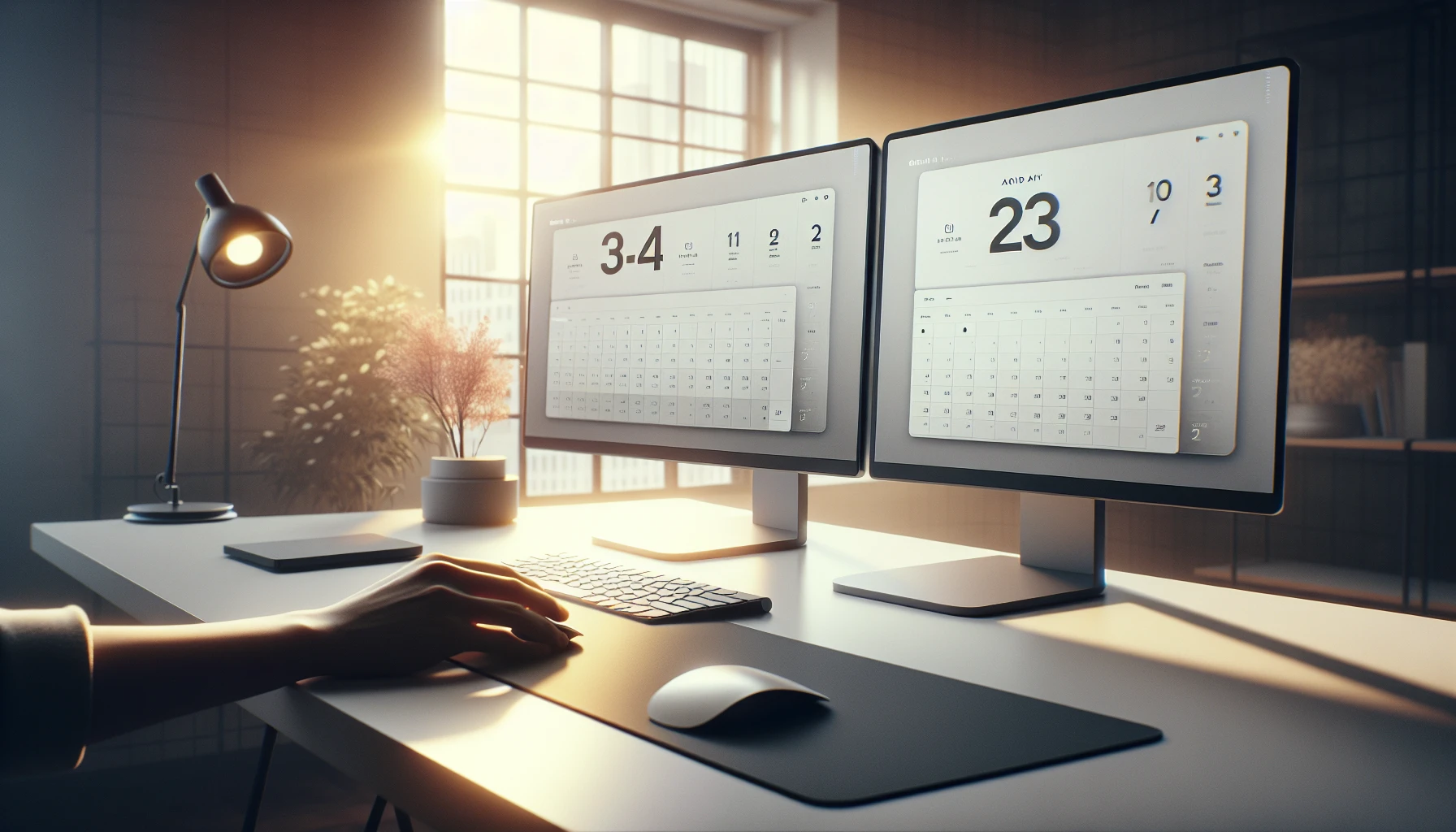· Ricardo Batista · 14 min read
Google Calendar Color Schemes - 5 Easy Ways to Boost Vibes
Give your calendar a fresh vibe with custom colors like neon and pastel, plus neat meeting tools to boost your day.

Ever thought about spicing up your calendar with custom colors? This article looks into mixing basic color hacks with preset options like neon and pastel to give your schedule a fresh vibe, while offering tips on handy tools such as Chrome Screen Recorder and Fireflies.ai; it explores design ideas and smart ways to manage your meetings and boost productivity.
Key Takeaways
- Using color schemes in your calendar helps you quickly see what’s happening
- Custom color options and tools like Coolors make finding your style fun and easy
- We show our expertise by automatically pinging attendees who arrive late to meetings, helping keep everything on track
- Shared calendars and simple guidelines ensure teams are on the same page
- A simple, flexible setup can boost your daily planning without feeling too tied down
Overview of Google Calendar Color Schemes
Google Calendar has built a reputation for being simple yet effective at organizing our busy lives. One feature that stands out is its color schemes. Using custom colors and pre-set palettes can help boost meeting workflows and even integrate custom hex codes for a truly personalized experience. With the right color schemes, you can instantly spot meetings, get reminders when attendees arrive late, and even add visual flair that reflects your personality.
The idea is simple: by assigning specific colors to different kinds of meetings or reminders, you automate a part of your workflow. For example, if you choose a bright neon to mark urgent tasks or a soft pastel for creative sessions, you can know at a glance what type of day lies ahead. This method works great if you want to automatically ping attendees that arrive late to your meetings, signaling that time is of the essence.
In this guide, we walk through fun ways to personalize your calendar, along with powerful tools that support a creative and efficient workflow.
Personalizing Your Calendar with Fun Palettes
Adding a personal touch to your calendar is more than just an aesthetic update—it improves how you manage your schedule. Using preset color palettes like Pink, Neon, and Pastel is a fun way to manage meeting reminders and highlight essential events. Here’s how different color options can serve various functions:
Choosing a Palette
- Pink: Use pink shades for creative brainstorming sessions or informal team meetings. The soothing yet vibrant tone helps set a relaxed yet focused atmosphere.
- Neon: Neon colors are perfect for urgent events or meetings that require immediate action. They stand out against more subtle backgrounds and remind you that these events are high priority.
- Pastel: Pastel tones work well for regular check-ins or routine updates. They lend an air of calm and balance to your day, making them ideal for long meetings or collaborative sessions.
Customizing your calendar with these colors makes it easier to spot important events and act on meeting reminders. As you adjust your schemes, consider the timing of your meetings. If you need to send automated pings to participants who are late, having a specific color designated for such reminders can help streamline the process.
The Benefits of Color-Coding for Meeting Reminders
Using color-coding isn’t just about looking good. It’s a strategic move that offers several benefits:
- Faster visual recognition of important tasks.
- A cleaner interface that reduces visual clutter.
- Enhanced productivity by grouping similar types of meetings.
- Better time management when meetings run over or attendees are late.
For more ideas on real-life implementations of meeting reminders and other calendar tweaks, you might find Meeting Reminders For Google Calendar a helpful resource.
How to Add Custom Colors to Your Google Calendar
Personalizing your calendar may seem daunting at first, but it’s really quite simple with the “add custom color” feature. Here is a step-by-step explanation:
Step-by-Step Custom Color Integration
- Step 1: Open Google Calendar
- Log in to your Google Calendar account through Google Calendar.
- Step 2: Access Calendar Settings
- Click on the settings gear icon at the top right and navigate to the “Settings” menu.
- Step 3: Choose a Calendar to Customize
- In the settings menu, select the specific calendar you want to edit from the list.
- Step 4: Customize Event Colors
- Look for the “Event color” or “Custom Colors” option. This is where the magic happens.
- Step 5: Add Your Custom Color
- Click on “Add custom color.” A dialogue box appears where you can type in a hex code or select from preset options like Pink, Neon, or Pastel.
- Step 6: Save Your Changes
- Confirm your choice by clicking “Save.” Now, your events will display in your chosen color scheme.
Each step is simple and straightforward. The process, when combined with clear meeting reminders, lets your calendar serve both as a functional scheduler and a visual planner. Adjust colors based on the status of meetings. For example, set a unique color to trigger an automated ping for late arrivals—a simple but effective strategy that keeps everyone on track.
Tools for Enhancing Creative Workflow
Beyond the basic customization of colors, several tools can boost your creative workflow and overall meeting productivity. These tools help streamline workflows, especially when used alongside Google Calendar’s reminder features.
Chrome Screen Recorder and AI Note-Taker for Google Meet
- Chrome Screen Recorder: This tool is handy when you want to capture a part of your meeting or need to share a recording with team members. It integrates with your browser, making it accessible and simple to use.
- AI Note-Taker for Google Meet: Transcribe conversations automatically during your meetings. This tool helps ensure that everyone gets a clear record of important decisions and follow-ups, so you can reference the notes later on.
These tools are also useful when paired with color-coded reminders. For instance:
- A neon-colored event may indicate a meeting that is being recorded. The color association quickly tells your team the importance of the session.
- Use AI Note-Taker during routine check-ins marked by pastel colors to supplement the calm and structured nature of the meeting.
Fireflies.ai for Meeting Productivity
Fireflies.ai is another powerful tool that directly ties into meeting productivity. The application records, transcribes, and organizes your meetings, ensuring that nothing important gets missed. With automated features, Fireflies.ai integrates seamlessly with your existing Google Calendar setup, making it easier to follow up on reminders such as pinging attendees when they are late.
If you’re looking to refine your workflow further, consider accessing Fireflies.ai for tutorials and product insights that can enhance your scheduling practices.
Utilizing Design Resources for Palette Generation
A visually appealing calendar is not only a tool for productivity but also a creative outlet. Utilizing design resources can give your calendar a professional yet personal look. Here are some useful design websites:
Coolors for Palette Generation
- Coolors is an excellent resource for generating color palettes. You can experiment with different combinations and even input your own hex codes to create the perfect look for your calendar.
- It allows you to see a range of colors and how they complement each other, making it easier to decide which palette best represents the tone of your various meetings.
Color-Hex for Detailed Color Specs
- Color-Hex is perfect for finding precise color values. If you have a specific hex code in mind or need detailed information on a color, this site provides detailed breakdowns and comparisons.
- Both tools work hand-in-hand with Google Calendar’s custom color features, letting you choose whether you prefer Pink, Neon, or Pastel hues for your different types of meetings.
Helpful Templates and Tutorials
- You can also use practical templates to further enhance your scheduling process. Google Docs Templates offer a range of options that you can use to coordinate your workflow with aesthetic planning.
- OC Templates provide more structured layouts that are perfect for keeping track of meeting details alongside your color-coded calendar.
Using these resources, you set a solid foundation for your calendar customization process. Each tool brings a unique value—from fostering creativity to ensuring that color choices are exactly what you need for clear visual reminders.
Real-Life Implementations and Productivity Tips
Real-life applications of these tools and customization strategies show how a well-organized calendar can revolutionize your workday, especially if you use color coding for automatic meeting reminders. Here are some practical tips and examples:
Real-Life Case Studies and Examples
- A design team used a distinctive pastel palette for brainstorming sessions, making it instantly clear which parts of the day were reserved for ideation versus client meetings.
- Sales teams might use neon to mark high-priority meetings. When a meeting runs over time, the neon marker helps trigger timed notifications to remind late comers about the schedule.
- Developers or project managers can create a system where specific colors indicate the phase of a project. If a meeting’s color changes, it signals that something important has shifted. This method was effective in a start-up environment, as team members quickly adapted to the new visual cues.
Tips for Aesthetic Planning and Increased Productivity
- Use a consistent color coding scheme. Choose specific colors for types of events—urgent, routine, creative, and client meetings. This minimizes confusion.
- Combine your color scheme with automated reminders. Using features that automatically ping attendees who arrive late keeps everyone accountable. For details on setting up these reminders, check out Calendar Meeting Reminders.
- Organize your day by dividing your calendar into segments. Use the “add custom color” feature to highlight each segment clearly. For example:
- Morning: Pastel tones for planning and routine checks.
- Afternoon: Neon hues for high-energy sessions.
- Evening: Pink or muted colors to wind down with reflective meetings or follow-ups.
- Regularly update your calendar. Keep your color codes and meeting statuses up to date. Adjust them as your workload or meeting dynamics change.
- Experiment with new color ideas every few weeks to avoid monotonous scheduling. Sometimes adding a fresh twist to your palette boosts creativity and prevents burnout.
By following these steps, you’re not only adding efficiency to your workflow but also making your scheduling process a bit more fun and personalized.
Integrating Meeting Tools with Color Schemes
Integrate these color schemes with meeting tools for a smoother experience. For example, using a Chrome Screen Recorder in tandem with a neon-marked meeting ensures that any important yet potentially overrunning sessions are recorded and revisited later. Similarly, when you pair an AI Note-Taker with a pastel theme meeting, you enhance the note-taking process by reducing visual distractions.
Using these integrations creates a workflow that is both visually appealing and highly functional. The color-coded system helps in quickly realizing which meeting might need a reminder for late arrivals and if certain tools need to be activated during a meeting. This setup can lead to increased accountability and timely starts.
Additional Styling Tips for a Streamlined Scheduling Environment
A visually appealing calendar can boost your daily productivity. Here are several additional ideas to refine your scheduling environment:
Experiment with Gradients and Shadows
- Try adding subtle gradients to your colors. For instance, a slight shadow effect on a neon hue can create a more dynamic look.
- Gradients can also help in differentiating between overlapping events, giving each one a unique visual signature.
Mix and Match Textures
- Although textures aren’t a direct feature in Google Calendar, you can mirror this effect with patterns in your meeting descriptions. In your notes section, include emojis or symbols that correspond to the color themes.
- Small visual cues, such as icons or background images in connected document templates, can reinforce the color coding you set up on your calendar.
Prioritize Clarity Over Excess
- Ensure that your color choices do not overwhelm the interface. Keep your palette limited to a few selected colors. Too many hues, even if they’re attractive, can make the calendar look cluttered.
- Use clear, descriptive names for calendar events to match with their color schemes. This ensures that anyone glancing at your schedule can easily understand the nature of each meeting.
Use Visual Hierarchies
- Separate primary meetings from follow-up tasks using variations in your color intensity. Heavier hues can signal important deadlines or critical meetings.
- Introduce a system where regular events have one tone and exceptional events have another. This strategy can tie into automated reminders that alert participants when they run late.
Leverage Digital Templates for Consistency
- Download pre-designed templates from Google Docs Templates or OC Templates. These templates can help you maintain a consistent style across all your work platforms.
- Templates that are designed with color-coded sections can be mirrored in your calendar, creating a seamless workflow from planning to execution.
In practice, visual consistency and unique identifiers not only keep you organized but also enhance overall team communication. Using a blend of color schemes and automation tools ensures that everyone knows what to expect, including automated pings when meetings go off schedule.
By experimenting with these styling tips, you can develop a visual language for your calendar that is both appealing and practical. The key is to find the right balance between aesthetics and efficiency, letting your calendar serve as both a planning tool and a creative outlet.
Utilizing these strategies is a fun and effective way to keep your day organized. As you explore custom colors, remember that the ideal setup is one that fits naturally into your workflow while adding a visual nudge for meeting reminders. Whether you’re using pink for relaxed brainstorming or neon for urgent tasks, each color can serve as a signal—a reminder that there’s a system in place to help manage even the busiest schedules.
This practical approach not only boosts individual productivity but fosters a more efficient and visually organized team environment. With tools like Chrome Screen Recorder, AI Note-Taker for Google Meet, and Fireflies.ai, the color-coded system in your Google Calendar becomes a central hub for managing time and meetings effectively, ensuring that no one misses out on important updates or reminders.
Conclusion
In wrapping things up, we revisited how custom color schemes and creative presets like neon and pastel can really brighten up your Google Calendar. This article showed you that a simple tweak in design adds personality and can help organize your schedule more naturally. We also looked at some cool tools such as the Chrome Screen Recorder and Fireflies.ai that make managing meetings easier and more efficient. Understanding how to use these tools can boost your meeting workflow and add a fun layer to your everyday planning.
Remember how important it is to keep your schedule both functional and visually appealing? With these insights, you now have a clear starting point to begin experimenting with colors and integrating helpful meeting tools into your workflow. As a next step, try out a few different presets and see which one feels right for your needs. And if you’re struggling with keeping meeting punctuality, know that Meeting Reminders is here to help by automatically pinging those who arrive late, making your life a bit smoother.
Related Posts
Frequently Asked Questions (FAQs)
How do Google Calendar color schemes help with organizing my schedule?
Using Google Calendar color schemes can make it way easier to see what’s happening at a glance. By assigning different colors to various events or tasks, you’ll know what’s most important. Whether you choose from preset palettes like Neon, Pastel, or custom hex codes, it’s a simple method to boost your productivity and keep track of deadlines and meetings.
How can I customize my Google Calendar color schemes?
You can customize your Google Calendar color schemes by using the “add custom color” option in your settings. This lets you pick a color that fits your style or the nature of your events. If you need inspiration, check out design tools like Coolors or Color-Hex which offer great ideas for palettes and perfect hex codes.
Can I integrate meeting tools along with Google Calendar color schemes?
Yes! Integrating different tools with your Google Calendar can take organization to the next level. Tools like Google Docs Templates help manage meeting workflows and you can even use Fireflies.ai to automatically record and transcribe your meetings. Combining these tools with visually-coded events makes your day flow smoother.
How do you automatically ping the attendees that arrive late to your meetings?
Our expertise shines when setting up a system that pings attendees who are late. By linking your Google Calendar events with a notification service or integrating an automation tool, you can set it up to send a quick message when someone is tardy. This helps manage meeting flow without manual effort and ensures everyone stays on track. Always remember to test your setup before live events so that it works seamlessly.
Are there tips for using Google Calendar color schemes for teams?
For teams, it’s best to use a consistent color strategy so everyone knows what each color represents. You might have red for deadlines, blue for meetings, and green for personal tasks. Share these guidelines in your team meetings or via shared documents, like those available at Google Docs Templates to help everyone stay aligned and make the most of your organized schedule.



